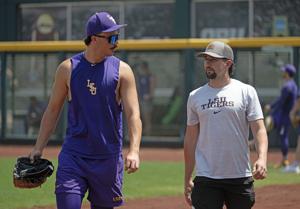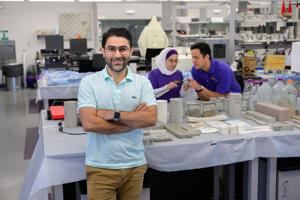
LSU right-hander Ty Floyd’s right hip is tighter than the other.
That’s what LSU strength coach Derek Groomer discovered in his initial evaluation. And like most coaches, he worked to correct it, increasing its range of motion. But when the change was made, it threw off Floyd’s sequencing.
Turns out, the tight hip worked to Floyd’s advantage, Groomer discovered. Before every game these days or in between innings, he uses a series of bands and exercises to make sure it stays that way.
It’s one of the things Groomer’s strength and conditioning program is designed to do — identify something about an athlete, then determine whether it works to his advantage or disadvantage through trial and error.
“Our biggest thing is learning to train the athlete as the individual for who they are, not necessarily train the athlete just because of what they play,” Groomer said.
It seems to be working for more than just LSU. Groomer was one of two interns under TCU assistant athletic director of human performance Zach Dechant, who also coached at this year’s College World Series.
Oral Roberts’ Andrew Nilo was the other intern at TCU, and his team’s June 16 CWS victory over TCU marked the first time Dechant had been beaten by his intern. Dechant’s intern tree also includes Arkansas strength coach Hunter Bell and Washington strength coach Joe Murray. Both teams qualified for NCAA regionals.
“He’s a big preacher about movement over max,” Nilo said. “What a lot of people don’t see is it’s not always about weight.”
That’s especially important for baseball players, who have trained much like football players when it comes to weight lifting and running. But so much of what they do is affected by the stillness in between the sporadic bursts of action, so keeping them healthy and loaded to make the next pitch is the objective.
“Baseball is all about speed, power, but when anybody does anything, it’s split-second fast and explosive,” Dechant said. “Generally, within the dynamics of the game, they move 1-3 seconds, and then they have long rest periods. Many coaches get carried away with long-distance running and mental toughness. That is not the sport of baseball.”
Start with the toes
Each of Dechant’s interns lean into a different aspect of strength training based on their team’s needs. Nilo is a “speed” guy who trains a lot of his athletes through sprint-based exercises. Groomer’s program is rooted in power through velocity-based training.
But first, the coaches put all their athletes through foundational testing. That’s how Groomer found out about Floyd’s hip.
Groomer’s testing is so detailed that it starts with the toes.
“Guys like Paul Skenes, we’ll see kind of when they’re on their foot: Which toes are twitching? Which ones are taking pressure?” Groomer said. “Which ones bounce back and forth and pressure as his body moves? When they’re walking, as your heel strikes: Which way does your toe go? Like do you go into your big toe? Do you go into the outside of your foot? Are you more flat-footed? Understanding that helps you understand how I load that leg in training.”
That helps set up workouts. For example, guys who are toe-dominant aren’t going to be doing front squats, because their heels are more likely to rise in the motion, causing injury. Groomer estimates he has about 30 different squat variations that are used on his athletes, depending on what he learns about their body.
“The variation you get depends on what your body tells us: Do you have the hips to do it?” Groomer said. “Are you already strong enough that it’s not going to pay off on the field?”
Squats are a common way to train for power, but they can also cause injury if too much weight is squatted.
In Groomer’s program, the weight a player squats is based on how his body feels that day. He has cameras that track the velocity in which a player moves the barbell in his squat motion. Based on that measurement, measured in meters per second, he can determine what that player’s max squat weight is that day. He tailors that workout for a player to squat a percentage of that weight in a certain number of reps.
“The program has to be written in pencil,” Dechant said. “Especially in the in-season, you auto regulate the training to the athlete, and that means we are able to adjust to the athletes in front of us based on how fatigued he already is, which is really important while they are playing. If he is tired, then that barbell tells us it’s moving slower than he usually does, so maybe he pulls back and we do less today.”
That’s also helpful for guys such as Dylan Crews, who will be starting his professional career after this college season.
“Guys like Dylan, we’re focusing on the draft and on keeping you healthy while trying to win the whole thing,” Groomer said. “I need you at your best while keeping you healthy.”
Injury prevention
Keeping infielders healthy is often difficult, since they stand on their toes while watching each batter. That causes tightness in the hamstrings, which can lead to lower-back problems when they tug on the pelvis, leading to more work on the lower back.
When a groundball is hit their way, that tightness can hold them back.
This is why Nilo’s program is largely rooted in speed. He believes in stimulating the nervous system because it’s the key governor of all human movements. But for infielders, he wants them to be flexible while also being fast, and that’s where he saw the most improvement in infielder Drew Stahl and first baseman Jake McMurray. Both had experienced a lot of back pain
Groomer said LSU’s entire infield lacked hamstring strength when he arrived. That was something he built through velocity-based training, and continues to evaluate game-to-game with “hamstring checks” and stretches. It’s especially important for shortstop Jordan Thompson, who is hunched over on his toes for hours in a game. Or Tommy White, who is similarly hunched in position but also takes bigger swings that put added stress on his lower back.
“Sometimes, my back might be tight, so we’ll be doing back extensions all day, doing stretches and yoga stuff,” White said. “He isn’t just going to work you out, he goes in there and just keeps your body right. He helps you feel good.”
That’s why evaluating the individual is important in the program, Dechant has taught Groomer and Nilo, because understanding the tendencies of each athlete takes one to two seasons to master and is constantly changing based on their needs.
“That’s one of the benefits of having a young coach,” Dechant said. “He’s going to create out-of-the-box methods to make you better.”



Leave a Reply